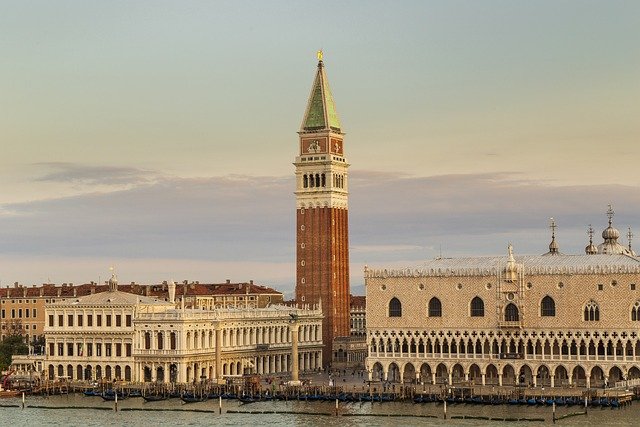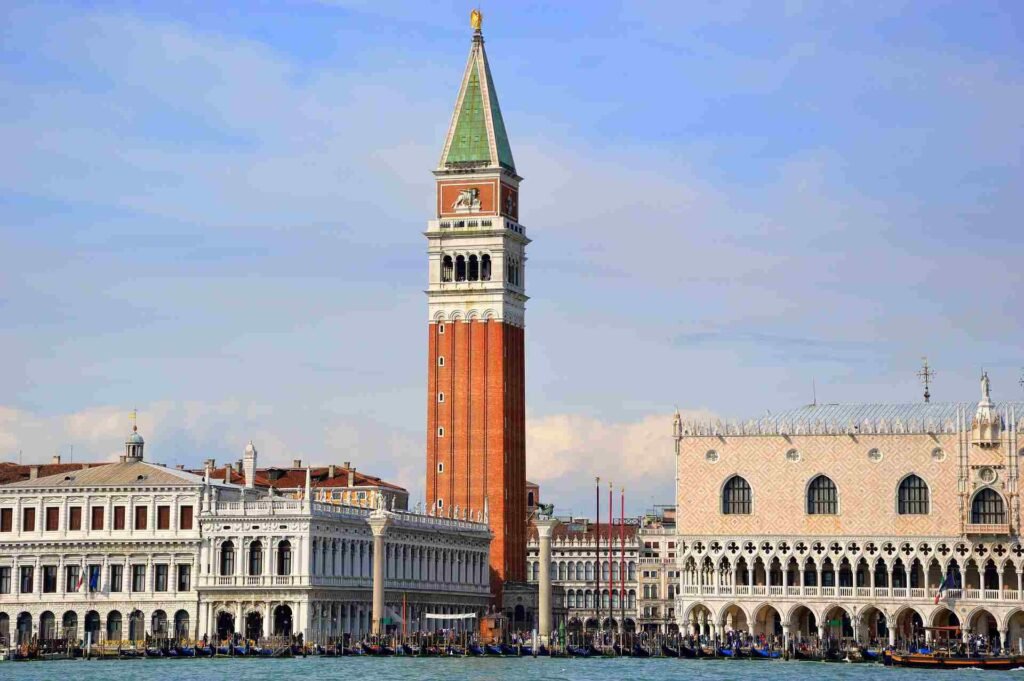Piazza San Marco, often called St. Mark’s Square, is one of the most famous landmarks in Venice, Italy. Known for its beauty, history, and cultural significance, this large open square has been the heart of Venetian life for centuries. Whether you’re visiting for the first time or returning to admire its grandeur, there’s plenty to learn about this iconic square.
What Can You See in Piazza San Marco?
Piazza San Marco is surrounded by some of Venice’s most important buildings and monuments.
St. Mark’s Basilica
One of the most impressive buildings in Venice, St. Mark’s Basilica is a stunning example of Byzantine architecture. Its grand domes, intricate mosaics, and richly decorated façade make it a must-see. Inside, the basilica holds incredible artworks, including the famous Pala d’Oro, a gold altar screen encrusted with jewels. The basilica has been the seat of the Venetian church for hundreds of years, and it’s still an active place of worship.
The Campanile
The Campanile di San Marco (St. Mark’s Bell Tower) is the tallest structure in Venice. Standing at 98 meters (323 feet), it offers breathtaking views of the city and the lagoon. Originally built as a lighthouse and lookout tower, the Campanile collapsed in 1902 but was rebuilt exactly as it was. Visitors can take an elevator to the top to enjoy panoramic views of Venice’s rooftops and the nearby islands.
Doge’s Palace
Located to the right of the basilica, the Doge’s Palace (Palazzo Ducale) was the political heart of Venice for centuries. This grand Gothic palace was home to the Doge, the ruler of Venice, and the seat of the government. Visitors can tour the palace, exploring rooms like the Hall of the Great Council and crossing the famous Bridge of Sighs, which connected the palace to the prison.
Museo Correr
The Museo Correr, located on the opposite end of the square, is a museum dedicated to the art, history, and culture of Venice. The museum is part of a larger complex that includes the National Archaeological Museum and the Marciana Library. Inside, you can see paintings, maps, statues, and even pieces of Venetian furniture.
The Clock Tower
One of the most unique buildings in Piazza San Marco is the Torre dell’Orologio, or Clock Tower. Built in the 15th century, this tower features a beautiful blue and gold clock face that shows the time, the phases of the moon, and the zodiac signs. At the top, two bronze figures known as the “Moors” strike the bell every hour.
A Brief History of Piazza San Marco
Piazza San Marco has been around since the 9th century, making it one of the oldest parts of Venice. It was originally just a small square in front of St. Mark’s Basilica, but over time, it expanded to become the grand space we see today. The square became a center for government, religious ceremonies, and major public events. It was, and still is, the gathering place for Venetians and visitors alike.
What to Do in Piazza San Marco?
While visiting Piazza San Marco, there are plenty of things to see and do to fully experience its beauty and history:
Take a Walk and Enjoy the Architecture
One of the best things to do is simply walk around and admire the buildings. Every corner of the square is rich in detail, from the ornate balconies of the basilica to the elegant arches of the Procuratie (the long buildings that line two sides of the square).
Sit at a Café
There are several famous cafés in Piazza San Marco where you can sit, relax, and enjoy a drink while taking in the lively atmosphere. Two of the most iconic are Caffè Florian and Caffè Quadri, which have been around since the 18th century. Though prices can be high (especially if you sit outside and enjoy live music), it’s worth it for the experience.
Watch the Pigeons
Piazza San Marco is known for its large number of pigeons, which have become part of the square’s charm. Many visitors enjoy watching them, and some even feed them (though this is no longer allowed).
Climb the Campanile
For the best view in Venice, take the elevator up to the top of the Campanile. From here, you can see all of Piazza San Marco below, the Grand Canal, and even the Dolomites mountains on a clear day.
Explore the Museums
Take time to visit the Museo Correr or the Doge’s Palace to learn more about Venice’s rich history. The museums are packed with artifacts, artwork, and exhibits that give you insight into the power and glory of the Venetian Republic.
When is the Best Time to Visit Piazza San Marco?
Piazza San Marco is beautiful at any time of year, but the experience can change depending on the season and time of day.
Spring and Fall: These seasons are ideal if you want to avoid the large summer crowds but still enjoy nice weather. In spring, the square is bright and lively, while fall brings a quieter, more peaceful atmosphere.
Summer: While summer is a popular time to visit, the square can be very crowded, especially in the middle of the day. Early morning or late evening are the best times to enjoy Piazza San Marco during the summer.
Winter: Visiting in winter, especially around Christmas, can be magical. The square is quieter, and there’s often a light fog that adds a mysterious charm. You might also experience acqua alta (high water), when parts of the square flood, creating beautiful reflections of the buildings in the water.
Practical Tips for Visiting Piazza San Marco
Arrive Early or Late: If you want to enjoy the square without the crowds, try visiting early in the morning or late in the evening. At these times, you’ll have a more peaceful experience and better opportunities for taking photos.
Beware of High Prices: Cafés and restaurants around Piazza San Marco are some of the most expensive in Venice. If you’re on a budget, you might want to save the café experience for a special treat.
Prepare for Acqua Alta: If you visit in the fall or winter, there’s a chance you’ll experience acqua alta, when the square floods. Elevated walkways are set up to help visitors move around, but it’s a good idea to have waterproof shoes on hand.
Respect the History: Piazza San Marco is not just a tourist destination but a place with deep historical and cultural significance. Always be respectful when visiting, especially inside religious buildings like St. Mark’s Basilica.



